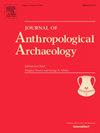安第斯高原上的狩猎到放牧:秘鲁的的喀喀湖盆地(9.0-3.5 ka)远古时期生存的动物考古学见解
IF 2
1区 社会学
Q1 ANTHROPOLOGY
引用次数: 0
摘要
本研究考察了位于南美洲安第斯山脉的的的喀喀湖盆地远古时期居民(9.0-3.5 cal. ka)的生存策略。研究人员利用来自秘鲁伊拉维地区三个古代遗址的动物数据,探索了5000多年来早期觅食者的饮食习惯。对比分析显示,人们在骆驼身上投入了大量资金,鹿只是次要的肉类。小型哺乳动物、鱼类和鸟类实际上都不存在。我们进一步观察到,随着时间的推移,相对于鹿,人们越来越重视骆驼类,这表明在调查期间,人们从狩猎转向了管理。我们没有发现饮食广度扩大、风险规避性觅食或气候引起的生存变化的证据。这些观察结果与之前的研究一致,这些研究记录了安第斯山脉其他地区从狩猎到放牧的转变。这一发现为早期骆驼在疑似驯化中心的管理提供了初步证据,并为促进的的喀喀湖流域农牧经济和社会经济复杂性出现的经济策略提供了关键见解。本文章由计算机程序翻译,如有差异,请以英文原文为准。
Hunting to herding on the Andean Altiplano: Zooarchaeological insights into Archaic Period subsistence in the Lake Titicaca Basin, Peru (9.0–3.5 ka)
This study examines the subsistence strategies of Archaic Period inhabitants (9.0–3.5 cal. ka) of the Lake Titicaca Basin, located in the high Andes of South America. Faunal data from three Archaic Period sites in the Ilave region of Peru are used to explore the dietary habits of early foragers spanning over five millennia. Comparative analysis reveals heavy investment in camelids, with deer serving as a secondary meat. Small mammals, fish, and birds are virtually absent from the assemblages. We further observe increasing emphasis on camelids relative to deer over time, suggesting a shift from hunting to management during the period of investigation. We fail to find evidence of diet breadth expansion, risk averse foraging, or climate-induced subsistence changes. The observations align with previous studies that document a transition from camelid hunting to herding in other regions of the high Andes. The findings provide preliminary evidence of early camelid management in a suspected domestication center and contribute key insights into the economic strategies that facilitated the emergence of agropastoral economies and socioeconomic complexity in the Lake Titicaca Basin.
求助全文
通过发布文献求助,成功后即可免费获取论文全文。
去求助
来源期刊

Journal of Anthropological Archaeology
Multiple-
CiteScore
4.00
自引率
11.10%
发文量
64
期刊介绍:
An innovative, international publication, the Journal of Anthropological Archaeology is devoted to the development of theory and, in a broad sense, methodology for the systematic and rigorous understanding of the organization, operation, and evolution of human societies. The discipline served by the journal is characterized by its goals and approach, not by geographical or temporal bounds. The data utilized or treated range from the earliest archaeological evidence for the emergence of human culture to historically documented societies and the contemporary observations of the ethnographer, ethnoarchaeologist, sociologist, or geographer. These subjects appear in the journal as examples of cultural organization, operation, and evolution, not as specific historical phenomena.
 求助内容:
求助内容: 应助结果提醒方式:
应助结果提醒方式:


